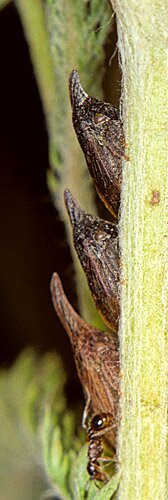
Family:Membracidae
Subfamily: Membracinae
Length: typically 8 mm from the tip of the horn to the rear of the insect
In this species the hind legs are spined, while the front two pairs of legs are foliaceous (leaf-like, that isbroad and flat). The eyes are prominent, while the ocelli are small and pearl-like.
The length of the pronotal horn and the shape of its curve vary from individual to individual.
A 1917 description of the life history of this species revealed that the eggs are laid at the base of the host plant. The nymphs move higher on the plant as they develop and molt. There are several generations per year, with the adults most common in late Summer. Overwintering is primarily in the egg stage.
Aaron Gove (2006) reported that in one species of Campylenchia the survival rate was far lower in aggregations that were not tended by ants, presumably because of increased predation and attacks by parasites, and because of the lack of removal of the treehoppers honeydew excretions, leading to fungal infections and even decreased mobility.
Reported host plants for Campylenchia latipes include Prairie Aster (Aster turbinellus), Milkwort (Polygala sp.), and Tickseed (Coreopsis tripteris).


